
One of literature’s most famous beach dwellers was Daniel Defoe’s “Robinson Crusoe”. Now often treated as politically incorrect, the work was nevertheless a literary staple for over 200 years, and an easy target for animators, who, especially in the 30’s, seemed to have an absolute passion for anything dealing with cannibals, and usually played up this angle of the story. In fact, it seems that animation’s cannibal tribes were almost evenly split between those hailing from darkest Adrica, and those inhabiting tropical islands. We will thus encounter several highspots of the latter variety in today’s article, with continuing recurrences of such theme in weeks to come. We’ll also visit some more placid tropical settings of white sandy shores, and a few visits to the hustle and bustle of the average urban beachfront where civilized mankind flocks to beat the heat.
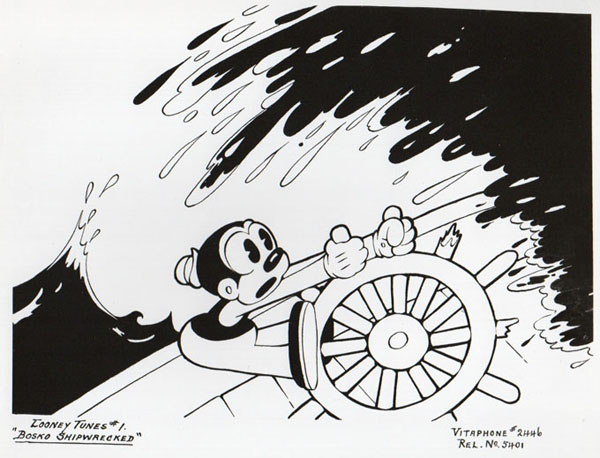
Sometimes I take a few artistic liberties with these columns. Thus, for stylistic sake, we begin this week’s survey with a film slightly out of chronological sequence – Bosko Shipwrecked! (Warner/Harman-Ising, Looney Tunes (Bosko) – 9/19/31 – Rollin Hamiltom/Larry Martin, anim.). Doing things this way allowed me to keep the Disney product and the Harman-Ising product together in groups instead of scattered, amd allowed the first installment of this trail to end on a creative high note, instead of with a film that has a feeling of being derivative. Released a mere six moths after the release of Mickey Mouse’s The Castaway (discussed last week), this film has the earmarks of being an “answer” to the Mickey adventure, and gives us another insight into the storyboard-to-film gestation time for an early sudio.
 The film’s actual highpoints occur before Bosko ever reaches the beach, in the form of a powerful and well-animated storm at sea, abounding in effects animation for waves, thunder and lightning. As storms may provide fodder for another trail to be potentially delved into in subsequent articles, I will for the time being let this film’s visuals speak for themselves as to the opening sequence, and jump to where Bosko washes up on what Bugs Bunny would later refer to in “Bugs Bunny Nips the Nips” as “the inevitable island”. Bosko, much like the literary Gulliver, lies exhausted on the shoreline, sound asleep. Two monkeys descend from a tree, cautiously creeping up on the sleeping figure, and abscond with Bosko’s derby. (Amazing in that, without a chin strap, this chapeau somehow manages to stay on Bosko’s head throughout the storm instead of being swept away by the waves or winds – but then, would we have wanted to endure a whole cartoon with a bald-headed Bosko?) As the two monkeys fight over the prize (one of them giving the other a pre-code raspberry), there seems to be a continuity break, suddenly finding both monkeys up a tree and shaking a branch containing a bird’s nest. (Any guesses if a scene was censored by the Guild Films distributors?) An egg falls out of the nest, waking Bosko with an egg shampoo. “Where am I?”. asks Bosko. A parrot breaks up with laughter, calling out to Bosko, “The yolk’s on you!”. Okay, maybe the line gets a chuckle the first time – but is there any justification for having the bird repeat this punchline three times? Mercifully, the bird falls, popping into the small end of a hollow wooden branch fallen from the tree, and coming out the large end completely shaved of feathers.
The film’s actual highpoints occur before Bosko ever reaches the beach, in the form of a powerful and well-animated storm at sea, abounding in effects animation for waves, thunder and lightning. As storms may provide fodder for another trail to be potentially delved into in subsequent articles, I will for the time being let this film’s visuals speak for themselves as to the opening sequence, and jump to where Bosko washes up on what Bugs Bunny would later refer to in “Bugs Bunny Nips the Nips” as “the inevitable island”. Bosko, much like the literary Gulliver, lies exhausted on the shoreline, sound asleep. Two monkeys descend from a tree, cautiously creeping up on the sleeping figure, and abscond with Bosko’s derby. (Amazing in that, without a chin strap, this chapeau somehow manages to stay on Bosko’s head throughout the storm instead of being swept away by the waves or winds – but then, would we have wanted to endure a whole cartoon with a bald-headed Bosko?) As the two monkeys fight over the prize (one of them giving the other a pre-code raspberry), there seems to be a continuity break, suddenly finding both monkeys up a tree and shaking a branch containing a bird’s nest. (Any guesses if a scene was censored by the Guild Films distributors?) An egg falls out of the nest, waking Bosko with an egg shampoo. “Where am I?”. asks Bosko. A parrot breaks up with laughter, calling out to Bosko, “The yolk’s on you!”. Okay, maybe the line gets a chuckle the first time – but is there any justification for having the bird repeat this punchline three times? Mercifully, the bird falls, popping into the small end of a hollow wooden branch fallen from the tree, and coming out the large end completely shaved of feathers.
 At this point, the derivative nature of this project begins to clearly show – as Bosko encounters a lion from nowhere, just as did Mickey Mouse, and a chase begins. To its credit, the sequence includes a very dimensional tracking shot, with the camera only a pace ahead of Bosko, while the lion approaches so closely that his paws protrude into the plane of the camera on either side of the screen – then reverses the angle for a tail-away track of the lion as the chase diverts in the other direction. (This is the kind of point-of-view tracking shot that New York’s Van Buren studio so often tried for in early Aesop’s Fables – but simply didn’t have the draftsmanship skills to truly pull off.) Then, talk about a rip-off. We get the identical setup from the Mickey Mouse cartoon, with Bosko standing on a rock in the river, between the lion and an alligator’s open jaws, and the same gag of the lion leaping over Bosko’s head and into the alligator’s mouth! The only difference is that, instead of tying the lion’s tail around the alligator’s mouth, Bosko ties the tail to a branch overhanging the river, suspending the gator out of water. (Not as effective a solution, as the gator could easily free himself by simply opening his mouth wider and letting the lion go – if he ever stops being hungry enough to allow him to think it through.) Civilization of some sort has apparently touched this island, as Bosko finds a rowboat (not marked as from his ship) in the river, and rows downstream. He finds inside a large, fully nautically-advanced ship’s anchor, and casts it over the side onto what appears to be a sand bar. With a loud “YEOW”, we and he discover the “bar” is actually a hippo, with the anchor point very painfully lodged into the skin of his backside. The hippo tows Bosko ashore, then disappears down a convenient hole, along with the rowboat, casting Bosko into the side of a boiling pot in a cannibal village. A savage appears, and pounds on his own stomach like a native drum, arousing the whole tribe of warriors. In one of the best gags of the short (though poorly synchronized), a skeleton rises from the boiling pot in Fleischeresque fashion, shakes Bosko’s hand, and says, “Come on in. The water’s fine.” Bosko attempts to delay the chief’s command of “Boil him” by pulling out a pistol and firing at point-blank range – inly to find he is carrying a pop-gun. Bosko runs for the shore, where he sees what appears to be an inflated rubber raft, and leaps in. The “raft” suddenly folds in half, revealing itself to have been the open jaws of a submerged rhino, which surfaces and swims away, while the luckless natives are left hungry on the shore. Out of the rhino’s heavy “armor plate” hide, Bosko reappears, merely pushing aside one of the plates to provide an escape hatch. He lifts from the rhino’s snout his horn as if completely unattached to the animal, and blows through it the old musical sting, “You’re a horse’s a–“ at the natives left behind, for the iris out.
At this point, the derivative nature of this project begins to clearly show – as Bosko encounters a lion from nowhere, just as did Mickey Mouse, and a chase begins. To its credit, the sequence includes a very dimensional tracking shot, with the camera only a pace ahead of Bosko, while the lion approaches so closely that his paws protrude into the plane of the camera on either side of the screen – then reverses the angle for a tail-away track of the lion as the chase diverts in the other direction. (This is the kind of point-of-view tracking shot that New York’s Van Buren studio so often tried for in early Aesop’s Fables – but simply didn’t have the draftsmanship skills to truly pull off.) Then, talk about a rip-off. We get the identical setup from the Mickey Mouse cartoon, with Bosko standing on a rock in the river, between the lion and an alligator’s open jaws, and the same gag of the lion leaping over Bosko’s head and into the alligator’s mouth! The only difference is that, instead of tying the lion’s tail around the alligator’s mouth, Bosko ties the tail to a branch overhanging the river, suspending the gator out of water. (Not as effective a solution, as the gator could easily free himself by simply opening his mouth wider and letting the lion go – if he ever stops being hungry enough to allow him to think it through.) Civilization of some sort has apparently touched this island, as Bosko finds a rowboat (not marked as from his ship) in the river, and rows downstream. He finds inside a large, fully nautically-advanced ship’s anchor, and casts it over the side onto what appears to be a sand bar. With a loud “YEOW”, we and he discover the “bar” is actually a hippo, with the anchor point very painfully lodged into the skin of his backside. The hippo tows Bosko ashore, then disappears down a convenient hole, along with the rowboat, casting Bosko into the side of a boiling pot in a cannibal village. A savage appears, and pounds on his own stomach like a native drum, arousing the whole tribe of warriors. In one of the best gags of the short (though poorly synchronized), a skeleton rises from the boiling pot in Fleischeresque fashion, shakes Bosko’s hand, and says, “Come on in. The water’s fine.” Bosko attempts to delay the chief’s command of “Boil him” by pulling out a pistol and firing at point-blank range – inly to find he is carrying a pop-gun. Bosko runs for the shore, where he sees what appears to be an inflated rubber raft, and leaps in. The “raft” suddenly folds in half, revealing itself to have been the open jaws of a submerged rhino, which surfaces and swims away, while the luckless natives are left hungry on the shore. Out of the rhino’s heavy “armor plate” hide, Bosko reappears, merely pushing aside one of the plates to provide an escape hatch. He lifts from the rhino’s snout his horn as if completely unattached to the animal, and blows through it the old musical sting, “You’re a horse’s a–“ at the natives left behind, for the iris out.
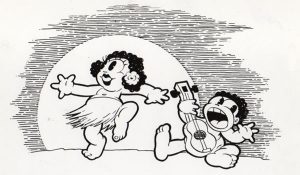 Pagan Moon (Warner, Merrie Melodies, 1/31/32 – Rollin Hamilton//Norm Blackburn, anim.) – If there was one thing that could be said about early 30’s Jarman Ising humanoid characters, they were nearly all interchangeable in nature and, for the most part, appearance. It didn’t matter whether your lead character was a red-headed doll, a toy soldier, an Indian brave or princess, or, as in this episode, an island boy and girl. You felt like you’d already seen them before, and knew just about everything they were going to do before thet did it. While the scene opens with the rising of the moon on an island shore, as the boy serenades on ukelele and the girl dances a hula, the dance still feels akin to the standard Harman-Ising shimmy that one would expect from Honey or any other female character. The boy even breaks into a Bosko-style vocal scat, while the girl reacts “Aloha – HAAA!”, falling just short of breaking into “boop oop a doop”s. We also have yet another appearance of the swaying cocoanut palm transforming into a skirted hula dancer, previously used in Bosko’s “Congo Jazz” and stolen from Walter Lantz’s “The King of Jazz” animated sequence for Paul Whiteman. Things, however, get considerably better, and much more well animated, about a third of the way into the film, when the boy’s ukelele falls out of his canoe into the sea. The boy dives in after it, leading to a nice angular perspective shot as he swims hard to make his descent.
Pagan Moon (Warner, Merrie Melodies, 1/31/32 – Rollin Hamilton//Norm Blackburn, anim.) – If there was one thing that could be said about early 30’s Jarman Ising humanoid characters, they were nearly all interchangeable in nature and, for the most part, appearance. It didn’t matter whether your lead character was a red-headed doll, a toy soldier, an Indian brave or princess, or, as in this episode, an island boy and girl. You felt like you’d already seen them before, and knew just about everything they were going to do before thet did it. While the scene opens with the rising of the moon on an island shore, as the boy serenades on ukelele and the girl dances a hula, the dance still feels akin to the standard Harman-Ising shimmy that one would expect from Honey or any other female character. The boy even breaks into a Bosko-style vocal scat, while the girl reacts “Aloha – HAAA!”, falling just short of breaking into “boop oop a doop”s. We also have yet another appearance of the swaying cocoanut palm transforming into a skirted hula dancer, previously used in Bosko’s “Congo Jazz” and stolen from Walter Lantz’s “The King of Jazz” animated sequence for Paul Whiteman. Things, however, get considerably better, and much more well animated, about a third of the way into the film, when the boy’s ukelele falls out of his canoe into the sea. The boy dives in after it, leading to a nice angular perspective shot as he swims hard to make his descent.
 On the ocean floor, he seems to lose focus on his objective of retrieving his original instrument, as he encounters a grand piano sunken from a shipwreck, on the keyboard of which two fish are playing hopscotch. The boy tries to seat himself on a stone as a piano stool, only to discover that the stone is a giant squid. Music hath charms to sooth the savage beast, so the kid starts plying, leading to a jazzy rendition of the title tine as various undersea creatures join in on cornet, trombone, etc. (Arrangement sounds surprisingly similar to Abe Lyman’s rendition of “You Don’t Know What You’re Doin’” from a previous film, though Abe isn’t on the credits.) The Squid is inspired, and tickles the ivories himself, adding a vocal bass solo to wow the undersea crowd. But the party is broken up when a large black gish chases the boy. Finding an old section of pipe left over from the sunken ship, the boy blows in one end, forming a bubble at the other. The boy enters the pipe and the bubble itself, then jiggles free of the pipe to float the the surface, out of the fish’s reach. The boy must blow some very hot air, as the bubble continues to rise into the sky, and is finally popped by a passing sea bird (who loses his feathers from the force of the explosion). The island girl reappears in a rowboat, but can’t row to the rescue fast enough, so she hops onto the back of a passing pelican, and tells the bird to “SCRAM”. A nick of time catch in the pelican’s beak saves the boy from a watery splash, and he and the girl ride inside the beak straight into the camera, as the pelican’s black body feathers envelop the screen for a black out.
On the ocean floor, he seems to lose focus on his objective of retrieving his original instrument, as he encounters a grand piano sunken from a shipwreck, on the keyboard of which two fish are playing hopscotch. The boy tries to seat himself on a stone as a piano stool, only to discover that the stone is a giant squid. Music hath charms to sooth the savage beast, so the kid starts plying, leading to a jazzy rendition of the title tine as various undersea creatures join in on cornet, trombone, etc. (Arrangement sounds surprisingly similar to Abe Lyman’s rendition of “You Don’t Know What You’re Doin’” from a previous film, though Abe isn’t on the credits.) The Squid is inspired, and tickles the ivories himself, adding a vocal bass solo to wow the undersea crowd. But the party is broken up when a large black gish chases the boy. Finding an old section of pipe left over from the sunken ship, the boy blows in one end, forming a bubble at the other. The boy enters the pipe and the bubble itself, then jiggles free of the pipe to float the the surface, out of the fish’s reach. The boy must blow some very hot air, as the bubble continues to rise into the sky, and is finally popped by a passing sea bird (who loses his feathers from the force of the explosion). The island girl reappears in a rowboat, but can’t row to the rescue fast enough, so she hops onto the back of a passing pelican, and tells the bird to “SCRAM”. A nick of time catch in the pelican’s beak saves the boy from a watery splash, and he and the girl ride inside the beak straight into the camera, as the pelican’s black body feathers envelop the screen for a black out.
 Bosko at the Beach (Warner, Looney Tunes, 7/23/32 – Isadore Freleng/Rollin Hamilton, anim.), while keeping up a lively pace, also falls into some embarassing moments when it is evident Hugh and Rudy were still looking over their shoulder to see how they could incorporate into their product what Disney had done before them. For starters, Bosko is a beachfront hot dog vendor with dancing hot dogs – the same way Oswald had been in “All Wet” and Mickey in “The Karnival Kid”. At least for once, the dogs don’t bark like little pups, and Bosko’s stand is in the form of a pushcart instead of fixed. At surf’s edge, a squid (six arms) cavorts with a school of sea horses, who hop onto the squid’s extended tentacles as he rotates, forming an aquatic merry-go-round. Honey and litte cat Wilbur are also out for the day, wading along the water’s edge while a well-drawn repeating cycle of oncoming waves approaches and recedes from the camera – repeatedly swamping Wilbur in their wake. Honey pulls Wilbur further up shore, and takes a position under a beach umbrella, where she plays a spirited umber on ukelele and performs a bit of a traditional Harman-Ising shimmy dance. Bosko’s hot dog wagon approaches from a vantage point where Bosko can see the dancing Honey in silhouette on the umbrella. “Hot dog!”, Bosko reacts, in a read suggesting anything but the food he is selling. Honey hears him, and is suddenly embarrassed at being seen in her bathing suit. She runs to a beach locker, and performs an identical reverse of the shot of Minnie Mouse from Wild Waves reviewed last week, pulling in from a clothesline, rather than sending out, an array of feminine underthings. She emerges in her traditional street clothes, and beckons Bosko over, showing him that she has a picnic lunch packed. The two set out the picnic upshore, though Bosko seems more interested in performing a version of “Ain’t We Got Fun” accompanied by Honey’s ukelele than in eating. Bosko’s dog Bruno meanwhile wants to play fetch the stick, and Bosko keeps pitching the wood so he can get a few moments of peace between throws to sing his song. Bruno, however, keeps bringing back sticks larger than the ones originally thrown – finally returning with a whole log, which he drops onto the picnic food, squashing most of the blanket’s contents, and flipping a large jar (are these Clarabelle’s olives?) onto Bosko’s head.
Bosko at the Beach (Warner, Looney Tunes, 7/23/32 – Isadore Freleng/Rollin Hamilton, anim.), while keeping up a lively pace, also falls into some embarassing moments when it is evident Hugh and Rudy were still looking over their shoulder to see how they could incorporate into their product what Disney had done before them. For starters, Bosko is a beachfront hot dog vendor with dancing hot dogs – the same way Oswald had been in “All Wet” and Mickey in “The Karnival Kid”. At least for once, the dogs don’t bark like little pups, and Bosko’s stand is in the form of a pushcart instead of fixed. At surf’s edge, a squid (six arms) cavorts with a school of sea horses, who hop onto the squid’s extended tentacles as he rotates, forming an aquatic merry-go-round. Honey and litte cat Wilbur are also out for the day, wading along the water’s edge while a well-drawn repeating cycle of oncoming waves approaches and recedes from the camera – repeatedly swamping Wilbur in their wake. Honey pulls Wilbur further up shore, and takes a position under a beach umbrella, where she plays a spirited umber on ukelele and performs a bit of a traditional Harman-Ising shimmy dance. Bosko’s hot dog wagon approaches from a vantage point where Bosko can see the dancing Honey in silhouette on the umbrella. “Hot dog!”, Bosko reacts, in a read suggesting anything but the food he is selling. Honey hears him, and is suddenly embarrassed at being seen in her bathing suit. She runs to a beach locker, and performs an identical reverse of the shot of Minnie Mouse from Wild Waves reviewed last week, pulling in from a clothesline, rather than sending out, an array of feminine underthings. She emerges in her traditional street clothes, and beckons Bosko over, showing him that she has a picnic lunch packed. The two set out the picnic upshore, though Bosko seems more interested in performing a version of “Ain’t We Got Fun” accompanied by Honey’s ukelele than in eating. Bosko’s dog Bruno meanwhile wants to play fetch the stick, and Bosko keeps pitching the wood so he can get a few moments of peace between throws to sing his song. Bruno, however, keeps bringing back sticks larger than the ones originally thrown – finally returning with a whole log, which he drops onto the picnic food, squashing most of the blanket’s contents, and flipping a large jar (are these Clarabelle’s olives?) onto Bosko’s head.
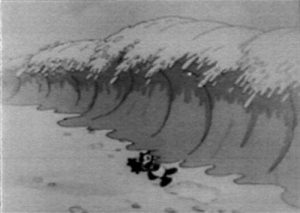 Meanwhile. Wilbur is repeating Minnie Mouse’s bit from “Wild Waves” by attempting to delicately dip his toes in shallow puddles of water, while dodging the crash of large waves that tower above him. As with Minnie, Wilbur is dragged out to sea. Boslo repeats the conduct of Mickey – attempting to launch himself into the ocean from the shore, but having a wave pill back from under him to leave him paddling on his stomach in the sand. Finally getting in over his head, Bosko vigorously dog-paddles, but has the surf raise him to a height of about six feet – then drop out from under him to make him belly-flop on the water. Bosko changes style, and repeats Mickey’s act again from “Wild Waves” by boring through the oncoming water like digging tunnels through a mountainside. And, wouldn’t you know it, we get a repeat of the bit from “All Wet” and “Wild Waves” where a wave keeps swelling up between Bosko and Wilbut to keep them from linking hands. This time, it’s up to Bruno to save the day. Bruno runs into a beach shack and finds an electric fan. Talk about continuity errors! While the fan is clearly depicted with a dangling, trailing electric cord in the first few shots, Bruno takes the device and jumps atop an old log next to the shoreline, pushing the log into the surf. Then, with no power source at all, Bruno merely turns the fan on and dips it in the water, making it serve as an outboard motor! )Even if he had a source of power, that power has been established as electric, not gasoline – something one would never want to insert underwater.). Bruno intercepts Bosko and Wilbur, then motors them to shore for an abrupt iris out. A half-baked and half-stolen plot, if ever there was one.
Meanwhile. Wilbur is repeating Minnie Mouse’s bit from “Wild Waves” by attempting to delicately dip his toes in shallow puddles of water, while dodging the crash of large waves that tower above him. As with Minnie, Wilbur is dragged out to sea. Boslo repeats the conduct of Mickey – attempting to launch himself into the ocean from the shore, but having a wave pill back from under him to leave him paddling on his stomach in the sand. Finally getting in over his head, Bosko vigorously dog-paddles, but has the surf raise him to a height of about six feet – then drop out from under him to make him belly-flop on the water. Bosko changes style, and repeats Mickey’s act again from “Wild Waves” by boring through the oncoming water like digging tunnels through a mountainside. And, wouldn’t you know it, we get a repeat of the bit from “All Wet” and “Wild Waves” where a wave keeps swelling up between Bosko and Wilbut to keep them from linking hands. This time, it’s up to Bruno to save the day. Bruno runs into a beach shack and finds an electric fan. Talk about continuity errors! While the fan is clearly depicted with a dangling, trailing electric cord in the first few shots, Bruno takes the device and jumps atop an old log next to the shoreline, pushing the log into the surf. Then, with no power source at all, Bruno merely turns the fan on and dips it in the water, making it serve as an outboard motor! )Even if he had a source of power, that power has been established as electric, not gasoline – something one would never want to insert underwater.). Bruno intercepts Bosko and Wilbur, then motors them to shore for an abrupt iris out. A half-baked and half-stolen plot, if ever there was one.
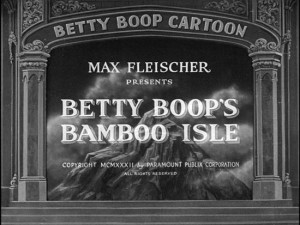 Betty Boop’s Bamboo Isle (Fleischer/Paramount, Betty Boop, 9/23/32 – Dave Fleischer, dir., Seymour Knietel/Bernard Wolf, anim.), has been visited once previously, in our “Toons Trip Out” vacation series of last year. To recap, this film, (featuring guest appearance by the Royal Samoans, whose hula dancer is rotoscoped to provide Betty’s dancing with some exotic flavor) begins with Bimbo on a sea voyage via speedboat, zooming in and out of the Panama Canal between Atlantic and Pacific Oceans. He runs into a rock and wrecks the ship, landing on a tropical island, where he plops down directly in the river canoe of island girl Betty. “Holy Smack”, Betty reacts (avoiding more obvious expletive). The canoe nearly goes over a waterfall while Bimbo serenades Betty, rescued only by the tugging of a school of fish. Back on land. Bimbo hears the approach of other natives, and decides to “blend in” by applying mud for a “brown-face” effect. His rendition of “Hawaiian War Chant” convinces the tribe he is one of them, and a gathering is held in his honor. Betty performs a sensuous hula dance, wearing only grass skirt and flower lei without bikini top (causing a nearby flower to comment “Oh, dear” and hide it’s face in the dirt). The festivities are dampened by a tropical rain shower, which washes off Bimbo’s make-up. He and Betty race to the shore, a step ahead of the natives. Bimbo’s boat miraculously reassembles itself (why didn’t it do this to begin with, and save us all this trouble?), and the two take to sea while the tribe follows in canoes. They wind up sailing up the Mississippi River, while the state of Florida land-locks the natives in the Gulf of Mexico. Betty and Bimbo share a kiss, seen through the hole of a busted umbrella, for the iris out.
Betty Boop’s Bamboo Isle (Fleischer/Paramount, Betty Boop, 9/23/32 – Dave Fleischer, dir., Seymour Knietel/Bernard Wolf, anim.), has been visited once previously, in our “Toons Trip Out” vacation series of last year. To recap, this film, (featuring guest appearance by the Royal Samoans, whose hula dancer is rotoscoped to provide Betty’s dancing with some exotic flavor) begins with Bimbo on a sea voyage via speedboat, zooming in and out of the Panama Canal between Atlantic and Pacific Oceans. He runs into a rock and wrecks the ship, landing on a tropical island, where he plops down directly in the river canoe of island girl Betty. “Holy Smack”, Betty reacts (avoiding more obvious expletive). The canoe nearly goes over a waterfall while Bimbo serenades Betty, rescued only by the tugging of a school of fish. Back on land. Bimbo hears the approach of other natives, and decides to “blend in” by applying mud for a “brown-face” effect. His rendition of “Hawaiian War Chant” convinces the tribe he is one of them, and a gathering is held in his honor. Betty performs a sensuous hula dance, wearing only grass skirt and flower lei without bikini top (causing a nearby flower to comment “Oh, dear” and hide it’s face in the dirt). The festivities are dampened by a tropical rain shower, which washes off Bimbo’s make-up. He and Betty race to the shore, a step ahead of the natives. Bimbo’s boat miraculously reassembles itself (why didn’t it do this to begin with, and save us all this trouble?), and the two take to sea while the tribe follows in canoes. They wind up sailing up the Mississippi River, while the state of Florida land-locks the natives in the Gulf of Mexico. Betty and Bimbo share a kiss, seen through the hole of a busted umbrella, for the iris out.
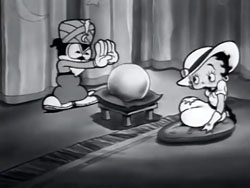 Another Betty, featuring beach shots and shopwreck, which I choose not to belabor again due to previous extended coverage in these columns, is Is My Palm Read (Fleischer/Paramount, Betty Boop, 2/17/33, Dave Fleischer, dir., David Tendlar/William Henning, anim.) One of the most heavily censored Boop cartoons, featuring ethnic jokes, lingerie shots, and even total nudity (of Betty as a “baby”), this twisted tale of fortune telling washes Betty ashore in a prediction of future peril upon an island far from deserted, as it is inexplicably inhabited by a hoard of hostile ghosts. The prediction, along with the assist and rescue participated in by fortune teller Bimbo, becomes all too true, in a sort of “here we go again” ending. For full details on this short, please visit my prior article, “Aw, Whadda You Afraid Of? (Part 1)”.
Another Betty, featuring beach shots and shopwreck, which I choose not to belabor again due to previous extended coverage in these columns, is Is My Palm Read (Fleischer/Paramount, Betty Boop, 2/17/33, Dave Fleischer, dir., David Tendlar/William Henning, anim.) One of the most heavily censored Boop cartoons, featuring ethnic jokes, lingerie shots, and even total nudity (of Betty as a “baby”), this twisted tale of fortune telling washes Betty ashore in a prediction of future peril upon an island far from deserted, as it is inexplicably inhabited by a hoard of hostile ghosts. The prediction, along with the assist and rescue participated in by fortune teller Bimbo, becomes all too true, in a sort of “here we go again” ending. For full details on this short, please visit my prior article, “Aw, Whadda You Afraid Of? (Part 1)”.
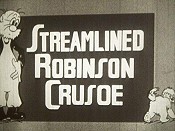
Castle Films re-title
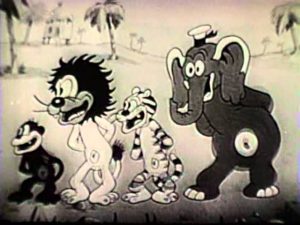 A musical number is presented, in which Defoe’s rescued native dubbed “Friday” is entirely recast as the resident king of the island, strumming a ukelele and serenading in Southern-dialect drawl along with a jungle of animals about the life of leisure they all lead in this paradise. Meanwhile, Al faces anything but leisure. Walking along the banks of a stream (and now carrying a rifle never previously seen aboard the raft), Al is closely followed by a pack of alligators in the water. One creeps ashore behind the farmer to take a bite upon his trousers. Al responds with ten shots in machine-gun fashion from his one-chamber rifle, but the gator merely laughs, as the bullets seem to have no effect upon his tough hide. Al is observed by a gang of other jungle creatures peering out between the trees as he passes. (The musical score during this sequence is notable, as Phillip Schieb does his best attempt to impersonate the strains of the Cab Calloway orchestra, which had received liberal use from the studio’s next-door rivals, the Fleischers, across town.) The parrot spots a set of human footprints in the sand, and tells the farmer, “We’re saved”. Al follows the two prints, which rise off the ground and advance step by step as if they were feet themselves, then mysteriously disappear down a hole in the ground. Al leans down, peering down the hole in attempt to figure out where the prints went, all the while unaware of the approach of a lion. The king of beasts is also intrigued by the farmer’s curiosity, and pushes Al aside to take a peek down the hole himself. Al and the lion take turns pushing each other aside, until a monkey in a tree decides to liven the confrontation up, by tossing a cocoanut onto the lion’s head. Thinking Al is getting aggressive, the lion slaps the farmer’s face. Al is up for the challenge, and counters with his best boxing footwork, putting up his dukes. The two battle it out in boxer/wrestler fashion, with the lion getting Al in a headlock, and Al countering by flipping the lion over his back. Al grabs his rifle, and holds it to the lion’s stomach. “I gotcha”, he intones in breathy satisfaction. For reasons unknown, his rifle’s barrel chooses this moment to wilt like a melting candle, and the lion delivers a sock to Al’s chin that skids him into the trunk of a cocoanut palm. Al’s parrot scares the lion by firing the gun anyway, but the bent barrel merely blasts into the farmer’s face, giving him a temporary “blackface” appearance.
A musical number is presented, in which Defoe’s rescued native dubbed “Friday” is entirely recast as the resident king of the island, strumming a ukelele and serenading in Southern-dialect drawl along with a jungle of animals about the life of leisure they all lead in this paradise. Meanwhile, Al faces anything but leisure. Walking along the banks of a stream (and now carrying a rifle never previously seen aboard the raft), Al is closely followed by a pack of alligators in the water. One creeps ashore behind the farmer to take a bite upon his trousers. Al responds with ten shots in machine-gun fashion from his one-chamber rifle, but the gator merely laughs, as the bullets seem to have no effect upon his tough hide. Al is observed by a gang of other jungle creatures peering out between the trees as he passes. (The musical score during this sequence is notable, as Phillip Schieb does his best attempt to impersonate the strains of the Cab Calloway orchestra, which had received liberal use from the studio’s next-door rivals, the Fleischers, across town.) The parrot spots a set of human footprints in the sand, and tells the farmer, “We’re saved”. Al follows the two prints, which rise off the ground and advance step by step as if they were feet themselves, then mysteriously disappear down a hole in the ground. Al leans down, peering down the hole in attempt to figure out where the prints went, all the while unaware of the approach of a lion. The king of beasts is also intrigued by the farmer’s curiosity, and pushes Al aside to take a peek down the hole himself. Al and the lion take turns pushing each other aside, until a monkey in a tree decides to liven the confrontation up, by tossing a cocoanut onto the lion’s head. Thinking Al is getting aggressive, the lion slaps the farmer’s face. Al is up for the challenge, and counters with his best boxing footwork, putting up his dukes. The two battle it out in boxer/wrestler fashion, with the lion getting Al in a headlock, and Al countering by flipping the lion over his back. Al grabs his rifle, and holds it to the lion’s stomach. “I gotcha”, he intones in breathy satisfaction. For reasons unknown, his rifle’s barrel chooses this moment to wilt like a melting candle, and the lion delivers a sock to Al’s chin that skids him into the trunk of a cocoanut palm. Al’s parrot scares the lion by firing the gun anyway, but the bent barrel merely blasts into the farmer’s face, giving him a temporary “blackface” appearance.
A native lookout in another tall tree spots the intruders, and sounds an alarm bell suspended in the palm fronds. Friday (now at a podium proclaiming himself to be “Judge Friday”, shouts into a microphone a police radio alert, calling all cars to investigate “something screwy at Main and Market.” Police cars of natives respond to the dragnet call, while other natives parade in 3-D perspective in a war dance. Al soon finds himself surrounded by a bevy of spear-carrying savages, who blindfold him and march him back to Friday’s throne. For little reason other than to provide window dressing, Terry chooses this late moment of the film to introduce a seductive white woman in a grass skirt and skimpy bikini top, held prisoner in a banboo cell, who moans in jazzy fashion about Al being another “prisoner just like me”, and that “He’ll be stewing in a pot. It won’t be long.” Al is set before the king, and peeks out from under his blindfold. In an entirely unexplained and conveniently abrupt ending, Al and Friday somehow recognize each other (we can only guess from their past adventures recounted by the book), and embrace instead of preparing the stewpot. The event turns into a reunion celebration, and the white girl easily escapes between her bamboo bars to dance in sensuous fasion over to the farmer, providing Al with an eye-popping dancing partner as she continues her jazzy music, accompanied by Friday on a mandolin, for the iris out. (The dance may have been “too hot to handle” for the censors, as many a similar number was treated in several Walter Lantz cartoons to keep them off the airwaves, and it will again be of historical curiosity if anyone can confirm whether this film was left in or out of the TV package.)
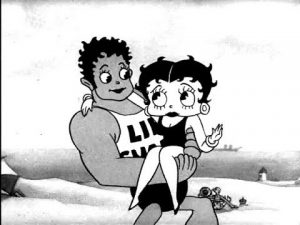 Betty Boop’s Life Guard (Fleischer/Paramount, Betty Boop, 7/13/34 – Dave Fleischer, dir., Willard Bowsky/Dave Tendlar, anim.). We return to a typical East Coast beach, of the type New Yorkers were well familiar with, consisting of a strip of sand below the pilings of a nearby pier. In a gag we will see again in this series, an energetic high surf alternates between sweeping the crowded beach clear of all signs of playful children, avid sub-worshippers, and inept bathers, with the force of one giant wave pulling them out to sea, then playfully replaces them all in their original positions on the next pass. Betty emerges in shapely bathing suit from a beach locker (at least with no clothesline for her discarded underthings), and spots a fat man asleep upon a beach lounge chair. Taking full advantage of his heavy snoring, Betty inserts into the man’s mouth the inflation tube of a rubber horse floatation device, and soon has her horse filled up with the recommended air pressure. However, before she can approach the waves, Betty’s rear-end is lassoed by a life preserver on the end of a rope, and she is gently lifted to the heights of a life-guard’s observation chair, where Fearless Fred watches over the day’s crowd. “Don’t go out too far, Betty. You know you can’t swim”, warns Fred. Betty assures him she’ll be all right, as she has her “horsie”. Fred lowers her back to the sand, and Betty tosses the horse into the waves, then climbs aboard. She “gallops” along atop the sea crests, until her craft springs a leak, and deflates to a meaningless strip of rubber. “Help, Freddie”, she calls, as she attempts to tread water. Freddie shows a brief moment of cowardice, the letters of the words “Life Guard” on his shirt shrinking to miniature size. But, he gets hold of himself, puffs out his chest to make the letters expand again, and performs a graceful dive from the platform toward the waves, assuming five picture-perfect diving poses along the way. Unfortunately, the effort is all for naught, as Fred has misjudged the distance, and merely lands face-first in the sand short of the water. Finally managing to enter the surf, Freddie travels as if he were engaged in a marathon, running atop the cresting waves by climbing each upward slope, then sliding down the downhill side. But Betty is floundering, and a watery “hand” formed by the white-tops of the swell counts off with its digits as Betty goes down for the third time. Fred peers frantically below the surface for sign of her, as Betty lapses into a severe case of “raptures of the deep”.
Betty Boop’s Life Guard (Fleischer/Paramount, Betty Boop, 7/13/34 – Dave Fleischer, dir., Willard Bowsky/Dave Tendlar, anim.). We return to a typical East Coast beach, of the type New Yorkers were well familiar with, consisting of a strip of sand below the pilings of a nearby pier. In a gag we will see again in this series, an energetic high surf alternates between sweeping the crowded beach clear of all signs of playful children, avid sub-worshippers, and inept bathers, with the force of one giant wave pulling them out to sea, then playfully replaces them all in their original positions on the next pass. Betty emerges in shapely bathing suit from a beach locker (at least with no clothesline for her discarded underthings), and spots a fat man asleep upon a beach lounge chair. Taking full advantage of his heavy snoring, Betty inserts into the man’s mouth the inflation tube of a rubber horse floatation device, and soon has her horse filled up with the recommended air pressure. However, before she can approach the waves, Betty’s rear-end is lassoed by a life preserver on the end of a rope, and she is gently lifted to the heights of a life-guard’s observation chair, where Fearless Fred watches over the day’s crowd. “Don’t go out too far, Betty. You know you can’t swim”, warns Fred. Betty assures him she’ll be all right, as she has her “horsie”. Fred lowers her back to the sand, and Betty tosses the horse into the waves, then climbs aboard. She “gallops” along atop the sea crests, until her craft springs a leak, and deflates to a meaningless strip of rubber. “Help, Freddie”, she calls, as she attempts to tread water. Freddie shows a brief moment of cowardice, the letters of the words “Life Guard” on his shirt shrinking to miniature size. But, he gets hold of himself, puffs out his chest to make the letters expand again, and performs a graceful dive from the platform toward the waves, assuming five picture-perfect diving poses along the way. Unfortunately, the effort is all for naught, as Fred has misjudged the distance, and merely lands face-first in the sand short of the water. Finally managing to enter the surf, Freddie travels as if he were engaged in a marathon, running atop the cresting waves by climbing each upward slope, then sliding down the downhill side. But Betty is floundering, and a watery “hand” formed by the white-tops of the swell counts off with its digits as Betty goes down for the third time. Fred peers frantically below the surface for sign of her, as Betty lapses into a severe case of “raptures of the deep”.
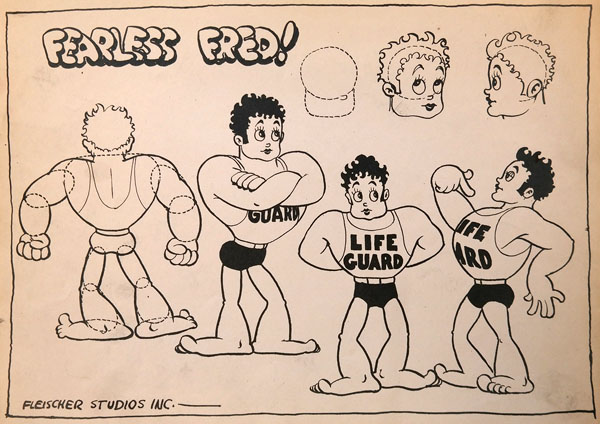
As we begin to see through Betty’s eyes, she is transformed into a mermaid, and the rising and falling of the waves transforms into a sextet of fish bouncing Betty up and down upon a fish net like an underwater trampoline. A musical number ensues in typical Boop fashion, as the confused Betty makes inquiry of the undersea creatures, “Where’s Freddie?” Participants in the number include an octopus around which smaller fishes dances, holding onto the creature’s arms like a Maypole, a pair of jellyfish who emerge from jelly jars, a sparking pair of electric eels dancing on their tails and lighting up their noses like bulbs, and a chorus line of small dancing fish, who are neatly picked up in a sardine can suspended from a fishing line. A demonstration of “survival of the fattest” ensues as one fish after another is swallowed by sea creatures of ever-increasing size, the last in the chain being a giant dragon-like eel, closely resembling the “jabberwock” from the earlier “Betty in Blunderland”. He is even accompanied by the identical musical cues as in the previous cartoon, a galloping version of Liszt’s Hungarian Rhapsody No. 2. The beast nips at Betty’s tail flippers, to which Mae Questal responds with her stock line, “You keep your hands to you.” The inevitable chase commences. A Jewish-dialect fish wanders the ocean floor, calling in part English, part Hebrew, something to the effect of “I cash clothes”, then reacts to the pass of the monster with an “Oy Yoy” and some unknown sentence entirely in Hebrew or Yiddish (readers: please provide translation), then heads for the hills. Nearby, two swordfish operate a grindstone wheel to sharpen their schnozzolas to rapier point, and seeing Betty in peril, launch themselves into the fray. They are of little effect, as the beast merely swallows them – though they cut themselves a trap-door escape out of his scaly hide. Betty is finally in the beast’s clutches (though she would seem to be in no immediate danger, given that the swordfish have already carved her an ulcerous means of escape), and calls again in song, “Where’s Freddie?” The scene shrinks into a though cloud above the real Betty’s head, who is now back on land, being carried ashore by a dripping Fred. Betty opens her eyes, and completes her song with a grateful, “Here’s Freddie, you son of a gun.”
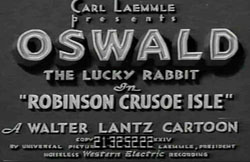 Robinson Crusoe Isle (Lantz/Universal, Oswald the Rabbit, 1/7/35). A recurring character, referred to by name in 1934’s “Ye Happy Pilgrims” as Harelip Harry, but bearing strong resemblance in appearance and mannerisms to Wimpy, receives the plum role of the title character, while Oswald plays himself as yet another shipwrecked sailor. Washing ashore on a raft, Oswald’s remaining belongings consist of a single transistor radio. He calls out “Yoo hoo” for signs of life. Three mountain peaks in the distance develop faces, and echo back the “yoo hoo” – all except the last one, who, after being nudged by the first two peaks, responds, “Oh, shut up!” Further along on the island, we encounter Harry as Robinson, followed by a small goat, as he tacks up help wanted signs with the assist of a bird to hammer in the nails in tree trunks. The signs advertise a job opening for a Man Friday. As Crusoe’s goat spots the tracks of Oswald, and Ozzie’s “Yoo hoo” is again heard, Crusoe follows the trail to the new arrival, playfully sneaking up behinf Oswald and letting out with his own “Yoo hoo”. He shows Oswald his signs, and asks if he’d like the job. Oswald gladly accepts, and Crusoe escorts Oswald back to his fortress encampment. Entrance to its bamboo gate is much easier than expected, as Crusoe merely uses an invisible zipper to part the bamboo down the middle. As he introduces his livestock to Oswald as the new job applicant, Crusoe also pulls out an ink stamp, and inks upon the back of Oswald’s pants “Friday 13″. “But where are the other Fridays?” asks Oswald. Crusoe blocks the view of a private room he has built within the bamboo stalks, in which is contained a pictorial memorial to 12 natives, reading, “In memory of my servants – Eaten by Cannibals”. Closing a door to the room behind him, Crusoe covers in his response to Oswald, claiming that the others are on a little vacation.
Robinson Crusoe Isle (Lantz/Universal, Oswald the Rabbit, 1/7/35). A recurring character, referred to by name in 1934’s “Ye Happy Pilgrims” as Harelip Harry, but bearing strong resemblance in appearance and mannerisms to Wimpy, receives the plum role of the title character, while Oswald plays himself as yet another shipwrecked sailor. Washing ashore on a raft, Oswald’s remaining belongings consist of a single transistor radio. He calls out “Yoo hoo” for signs of life. Three mountain peaks in the distance develop faces, and echo back the “yoo hoo” – all except the last one, who, after being nudged by the first two peaks, responds, “Oh, shut up!” Further along on the island, we encounter Harry as Robinson, followed by a small goat, as he tacks up help wanted signs with the assist of a bird to hammer in the nails in tree trunks. The signs advertise a job opening for a Man Friday. As Crusoe’s goat spots the tracks of Oswald, and Ozzie’s “Yoo hoo” is again heard, Crusoe follows the trail to the new arrival, playfully sneaking up behinf Oswald and letting out with his own “Yoo hoo”. He shows Oswald his signs, and asks if he’d like the job. Oswald gladly accepts, and Crusoe escorts Oswald back to his fortress encampment. Entrance to its bamboo gate is much easier than expected, as Crusoe merely uses an invisible zipper to part the bamboo down the middle. As he introduces his livestock to Oswald as the new job applicant, Crusoe also pulls out an ink stamp, and inks upon the back of Oswald’s pants “Friday 13″. “But where are the other Fridays?” asks Oswald. Crusoe blocks the view of a private room he has built within the bamboo stalks, in which is contained a pictorial memorial to 12 natives, reading, “In memory of my servants – Eaten by Cannibals”. Closing a door to the room behind him, Crusoe covers in his response to Oswald, claiming that the others are on a little vacation.
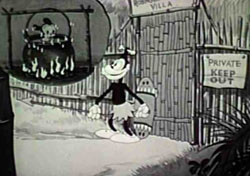 Outside the compound, a cannibal warrior peers into a keyhole, and spotting the new arrival, sees in a thought cloud visions of fresh rabbit meat simmering in a pot. “Wait’ll I tell the boys”, he beams, and heads off toward his tribal village. Back inside the compound, Oswald shows off his transistor radio. “What’s this funny gadget?”, asks Crusoe. Oswald demonstrates by tuning in a program. With shocking volume, the show turns out to be Ed Wynn as the Texaco fire chief, complete with clanging bells and screaming siren, which sends the shocked Crusoe and his animals scurrying up a tree. As Oswald shuts off the program, Cruesoe calls out, in the catch-phrase and voice of Joe Penner, “Don’t ever doooo that!” Oswald retunes the radio, to demonstrate that it can supply more peaceful entertainment, and finds an original jazzy tune, which, for lack of a more obvious title, we’ll call “Dancing to a Tom Tom”. Cruesoe and the animals smile, and descend from the tree. Soon, everyone is dancing. Crusoe with his cow, a cat with a ,ouse, etc. At the cannibal village, the scout warrior reports on Oswald, in mumbo jumbo words ending with “Friday”. The tribal chief responds with more mumbo jumbo, ending with the words, “Bring him back alive”, as the chief produces from behind his throne a ready knife and fork.
Outside the compound, a cannibal warrior peers into a keyhole, and spotting the new arrival, sees in a thought cloud visions of fresh rabbit meat simmering in a pot. “Wait’ll I tell the boys”, he beams, and heads off toward his tribal village. Back inside the compound, Oswald shows off his transistor radio. “What’s this funny gadget?”, asks Crusoe. Oswald demonstrates by tuning in a program. With shocking volume, the show turns out to be Ed Wynn as the Texaco fire chief, complete with clanging bells and screaming siren, which sends the shocked Crusoe and his animals scurrying up a tree. As Oswald shuts off the program, Cruesoe calls out, in the catch-phrase and voice of Joe Penner, “Don’t ever doooo that!” Oswald retunes the radio, to demonstrate that it can supply more peaceful entertainment, and finds an original jazzy tune, which, for lack of a more obvious title, we’ll call “Dancing to a Tom Tom”. Cruesoe and the animals smile, and descend from the tree. Soon, everyone is dancing. Crusoe with his cow, a cat with a ,ouse, etc. At the cannibal village, the scout warrior reports on Oswald, in mumbo jumbo words ending with “Friday”. The tribal chief responds with more mumbo jumbo, ending with the words, “Bring him back alive”, as the chief produces from behind his throne a ready knife and fork.
Meanwhile, back at the compound, the dance party is brought to an unexpected halt, when Crusoe’s goat swallows the radio, reducing the signal to static. Oswald chases the goat to get the radio back, and the two of them collide with and bust a hole through the bamboo door of Crusoe’s memorial. There, Oswald sees the shocking truth about what happened to the other 12 Fridays, and responds “Whoa ho!”. He charges back out the hole astride the goat, bowling over Crusoe, and breaks another hole through the outer compound wall to freedom. A beautifully-detailed three-dimensional tail away shot follows, as the camera tracks Oswald down a path between dense jungle foliage – where he encounters the oncoming cannibal tribe, and reverses direction to run directly toward the camera, with the cannibals close on his heels. He takes a path that appears to leave the cannibals following the wrong trail, as their shouts become more distant. However, the goat is slowing, and a turtle passes them easily. To make matters worse, the radio inside the goat has now turned in a kiddie show, where the announcer is concluding a soothing bedtime story – putting the goat to sleep. The rising sound of tom toms and shouting cues Oswald that the natives are back on the trail. Watch for a curious animation error, as Oswald drags the sleeping goat behind a tree – with at least one cel traced out of registration with the others, causing the characters to violently “jump” on each repeated walk cycle. The goat revives, and Oswald signals him to keep quirt while the natives pass on the other side of the tree. The goat nods yes – until the radio chooses this inopportune moment to tune in on Kate Smith. greeting her audience with a clearly audible “Hello, everybody.” They are hidden no more.
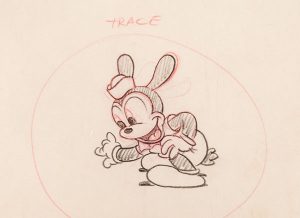 Ozzie and the goat quickly find themselves in the cannibal soup pot, while the tribe dances a war dance around them. The tribe’s cook pulls the goat out of the pot by the horns, probing the goat’s belly with a fork to see if he’s done. The fork encounters the radio tuner, which somehow finds the performance of the same tune which started Crusoe’s animals dancing. The music has the same effect on the natives and the chief, who suddenly become peaceable and oblivious to everything as they dance to the music. Oswald is able to climb out of the pot without protest or confrontation, and shakes the goat’s hand for the unexpected rescue. Back in the vicinity of the compound, Crusoe is back at work posing new “help wanted” signs, when he hears the approach of Oswald’s music. Crusoe gasps, as he sees Oswalf and the goat, closely followed behind by the entire cannibal tribe. However, Oswald shows Crusoe that there is nothing to fear – as each of the cannibals has come in peace, as Crusoe’s new job applicants. Each native turns his rear end to Crusoe and the camera, revealing that their shorts under their grass skirts have already been pre-inked bu Oswald with the word “Friday”, followed by various identifying numbers. Oswald notices one small native he missed, still with his shorts blank, and ink-stamps on his rear, “Friday 6 7/8″, for the iris out.
Ozzie and the goat quickly find themselves in the cannibal soup pot, while the tribe dances a war dance around them. The tribe’s cook pulls the goat out of the pot by the horns, probing the goat’s belly with a fork to see if he’s done. The fork encounters the radio tuner, which somehow finds the performance of the same tune which started Crusoe’s animals dancing. The music has the same effect on the natives and the chief, who suddenly become peaceable and oblivious to everything as they dance to the music. Oswald is able to climb out of the pot without protest or confrontation, and shakes the goat’s hand for the unexpected rescue. Back in the vicinity of the compound, Crusoe is back at work posing new “help wanted” signs, when he hears the approach of Oswald’s music. Crusoe gasps, as he sees Oswalf and the goat, closely followed behind by the entire cannibal tribe. However, Oswald shows Crusoe that there is nothing to fear – as each of the cannibals has come in peace, as Crusoe’s new job applicants. Each native turns his rear end to Crusoe and the camera, revealing that their shorts under their grass skirts have already been pre-inked bu Oswald with the word “Friday”, followed by various identifying numbers. Oswald notices one small native he missed, still with his shorts blank, and ink-stamps on his rear, “Friday 6 7/8″, for the iris out.
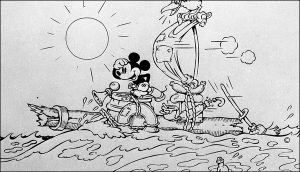 As usual, probably the epitome of animated Robinson Crusoe retellings comes from Disney, in the action-packed adventure, Mickey’s Man Friday (Disney/UA, Mickey Mouse, 1/19/35 – David Hand, dir.). Also as usual, Mickey is castaway aboard a raft, this time more elaboartely provisioned with a ship’s barrel, vatous tools, food and provisions, and even an old auto horn Mickey has taken aboard from somewhere, to shoo off stray sea birds that swim in the raft’s path. He washes onto a beach shore, and immediately spots footprints in the sand, then hears the beat of native tom toms. Creeping closer under the cover of the wild foliage, Mickey observes a cannibal tribe around a large cooking pot, over which has been erected a scaffolding to provide a sort of on-land “walk the plank” into the pot for the cannibals’ latest entree – that is, victim. A blindfolded black islander, presumably not of the same tribe, walks the rickety board at spear-point, with hands tied and blindfolded. Mickey realizes the little guy needs help, and, retrieving the ship barrel and some cans of paint from his supplies, begins drawing an evil face on the barrel’s side. A few moments later, he emerges from the underbrush, walking on bamboo stilts and concealed inside the barrel, which he has painted to resemble the face of an evil spirit. To add to the illusion, Mickey utters his best yells and screams from inside the barrel, and periodically honks the auto horn inside. The cannibal tribe is appropriately spooked, and take to their canoes, leaving the island and their intended victim behind. The native prisoner (voiced by basso Billy Bletcher) is freed, and bows to Mickey in gratitude. Mickey dubs him Friday, and after attempts at introduction (in which the native can’t pick up on pronoun lingo to figure out who is named “Friday” and who is named “Mickey”), Mickey suggests they immediately begin work on building a fort, in case Friday’s “friends come back” – a thought that gives Friday the shudders.
As usual, probably the epitome of animated Robinson Crusoe retellings comes from Disney, in the action-packed adventure, Mickey’s Man Friday (Disney/UA, Mickey Mouse, 1/19/35 – David Hand, dir.). Also as usual, Mickey is castaway aboard a raft, this time more elaboartely provisioned with a ship’s barrel, vatous tools, food and provisions, and even an old auto horn Mickey has taken aboard from somewhere, to shoo off stray sea birds that swim in the raft’s path. He washes onto a beach shore, and immediately spots footprints in the sand, then hears the beat of native tom toms. Creeping closer under the cover of the wild foliage, Mickey observes a cannibal tribe around a large cooking pot, over which has been erected a scaffolding to provide a sort of on-land “walk the plank” into the pot for the cannibals’ latest entree – that is, victim. A blindfolded black islander, presumably not of the same tribe, walks the rickety board at spear-point, with hands tied and blindfolded. Mickey realizes the little guy needs help, and, retrieving the ship barrel and some cans of paint from his supplies, begins drawing an evil face on the barrel’s side. A few moments later, he emerges from the underbrush, walking on bamboo stilts and concealed inside the barrel, which he has painted to resemble the face of an evil spirit. To add to the illusion, Mickey utters his best yells and screams from inside the barrel, and periodically honks the auto horn inside. The cannibal tribe is appropriately spooked, and take to their canoes, leaving the island and their intended victim behind. The native prisoner (voiced by basso Billy Bletcher) is freed, and bows to Mickey in gratitude. Mickey dubs him Friday, and after attempts at introduction (in which the native can’t pick up on pronoun lingo to figure out who is named “Friday” and who is named “Mickey”), Mickey suggests they immediately begin work on building a fort, in case Friday’s “friends come back” – a thought that gives Friday the shudders.
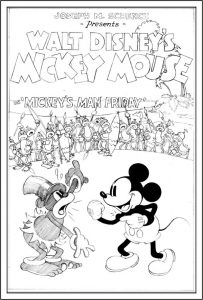 Construction begins in earnest. In flawless multi-layer perspective panning, Mickey takes mighty axe swipes at two opposite rows of palm trees, felling trees left and right on each swing for needed wood. Friday tries the same trick, using his feet instead of his hands to grasp the axe, and succeeds in breaking a palm tree trunk into multiple separate segments, causing the tree to collapse upon himself and dump its supply of cocoanuts and palm fronds atop his head. Still, Friday smiles, at what he considers a job well done. Next, Mickey uses a home-made flute to charm a local snake into dragging long strips of tree bark into knots around a line of bamboo fence poles, binding the poles tightly together for a reinforced wall. Friday tap-dances on the back of a large turtle, vibrating the turtle’s head into something of an automatic hammer to tack the bamboo walls to wooden cross-beams. The boys next construct a tall central observation tower, with Mickey using a pelican’s beak as his portable tool box for hardware from the ship, while Friday constructs thatched roofs with palm fronds, using a crane’s beak as a giant scissor to trim the ends of the roof fronds even, as if providing a very large haircut. A flagpole is finally erected, on which a homemade flag (made of an old sweater) is raised reading “Fort Robinson Crusoe”, with the crowning touch of the pelican taking his place atop the pole and spreading his wings majestically, providing his best impression of an American eagle. The boys salute the bird, then exchange a congratulatory handshake – that is, between Mickey’s hand and Friday’s foot.
Construction begins in earnest. In flawless multi-layer perspective panning, Mickey takes mighty axe swipes at two opposite rows of palm trees, felling trees left and right on each swing for needed wood. Friday tries the same trick, using his feet instead of his hands to grasp the axe, and succeeds in breaking a palm tree trunk into multiple separate segments, causing the tree to collapse upon himself and dump its supply of cocoanuts and palm fronds atop his head. Still, Friday smiles, at what he considers a job well done. Next, Mickey uses a home-made flute to charm a local snake into dragging long strips of tree bark into knots around a line of bamboo fence poles, binding the poles tightly together for a reinforced wall. Friday tap-dances on the back of a large turtle, vibrating the turtle’s head into something of an automatic hammer to tack the bamboo walls to wooden cross-beams. The boys next construct a tall central observation tower, with Mickey using a pelican’s beak as his portable tool box for hardware from the ship, while Friday constructs thatched roofs with palm fronds, using a crane’s beak as a giant scissor to trim the ends of the roof fronds even, as if providing a very large haircut. A flagpole is finally erected, on which a homemade flag (made of an old sweater) is raised reading “Fort Robinson Crusoe”, with the crowning touch of the pelican taking his place atop the pole and spreading his wings majestically, providing his best impression of an American eagle. The boys salute the bird, then exchange a congratulatory handshake – that is, between Mickey’s hand and Friday’s foot.
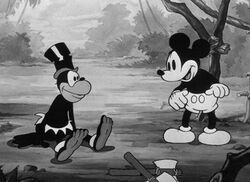 We’re only four minutes into this eight minute cartoon, and the cannibals are coming back. Get set for four more minutes of absolutely non-stop action, of the ultra-expensive, complex and flawless variety only Disney could afford to present. The boys have ensured not only that fortifications are in place, but that a wide variety of secret weapons and booby-traps abound. An advance scout of the returning tribe is the first to run afoul of a concealed snare trap, which, as it yanks the savage aloft by the ankle with a springy sapling, also lets his weight bounce the tree up and down, activating a second rope attached to the tree’s topmost foliage, which raises and lowers a hinged weight upon the bulb of Mickey’s old auto horn, providing an intruder alarm. The boys hear it, and assume their battle stations. Mickey mounts an elevator platform, fastened by gear to a treadmill which Friday powers, elevating Mickey up to command central in the observation tower, while Friday prepares to wage a ground war. Seeing the natives approaching the main gate, Mickey pulls a lever, releasing the elevated gate to fall down upon the first row of natives. The bottom of the gate is equipped with semi-circular holes cit in a wooden crossbeam – thus trapping the advance-line of natives as if locked in medieval stocks. Other natives raise a ladder to the wall. Mickey counters by jumping on a hinged control, tethered to a mechanism at the top of the wall to punch each ascending native in the face with a boxing glove. (Not only is it convenient that Mickey has rescued such a glove from the ship, but, as revealed when the mechanism’s final blow fractures the glove leather, Mickey also has an ample supply of iron horseshoes to “load” the glove.) From the opposite side of the fort, a lone native tries to help his friends by taking matters into his own hands, setting himself to toss a spear at Mickey’s tower. Mickey again counters in the nick of time with a booby trap, pulling another rope whick pulls upwards around the native the large petals of a jungle flower upon which the native is standing – artificially replicating a man-eating plant.
We’re only four minutes into this eight minute cartoon, and the cannibals are coming back. Get set for four more minutes of absolutely non-stop action, of the ultra-expensive, complex and flawless variety only Disney could afford to present. The boys have ensured not only that fortifications are in place, but that a wide variety of secret weapons and booby-traps abound. An advance scout of the returning tribe is the first to run afoul of a concealed snare trap, which, as it yanks the savage aloft by the ankle with a springy sapling, also lets his weight bounce the tree up and down, activating a second rope attached to the tree’s topmost foliage, which raises and lowers a hinged weight upon the bulb of Mickey’s old auto horn, providing an intruder alarm. The boys hear it, and assume their battle stations. Mickey mounts an elevator platform, fastened by gear to a treadmill which Friday powers, elevating Mickey up to command central in the observation tower, while Friday prepares to wage a ground war. Seeing the natives approaching the main gate, Mickey pulls a lever, releasing the elevated gate to fall down upon the first row of natives. The bottom of the gate is equipped with semi-circular holes cit in a wooden crossbeam – thus trapping the advance-line of natives as if locked in medieval stocks. Other natives raise a ladder to the wall. Mickey counters by jumping on a hinged control, tethered to a mechanism at the top of the wall to punch each ascending native in the face with a boxing glove. (Not only is it convenient that Mickey has rescued such a glove from the ship, but, as revealed when the mechanism’s final blow fractures the glove leather, Mickey also has an ample supply of iron horseshoes to “load” the glove.) From the opposite side of the fort, a lone native tries to help his friends by taking matters into his own hands, setting himself to toss a spear at Mickey’s tower. Mickey again counters in the nick of time with a booby trap, pulling another rope whick pulls upwards around the native the large petals of a jungle flower upon which the native is standing – artificially replicating a man-eating plant.
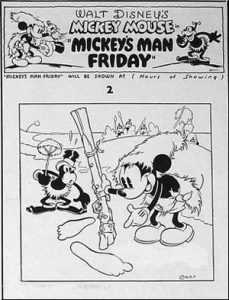 Friday goes to work on the lower-level battle. He begins to shoot through a hole placed in the banboo wall giant spears, propelled by slapping their handle-ends with the head of am axe gastened to another springy sapling. His first shot misses the ducking natives, but connects with a palm tree, which shakes in surprise, losing all its cocoanuts. Friday’s second shot is on target, penetrating the tops of the shields of seven natives like threading a needle, then pinning them to the trunk of another tree, while a second shot penetrates the bottoms of each spear, making the whole group into a nicely-trapped multi-layer sandwich. In the tower, Mickey sends the pelican on a flight over enemy lines, loading the bird’s beak with cocoanuts, and looping a rope around the tip of the pelican’s lower bill. As the bird soars past the fort wall, it flies over a circle of spear-throwing natives. Mickey pulls the rope, opening the pilican’s lower jaw like a bomb bay. Each falling cocoanut drives a native into the sand like a pile driver. Back at the main gate, two squads of cannibals try their hand at their own designs of battering ram. The first uses a traditional felled palm tree. However, the wall is so well constructed that the tree is merely compressed by the impact from long and tall to short and squatty. A second squad piles four natives atop each other in totem pole fashion,, then uses them as a human ram. All that is accomplished is to cause the four natives’ torsos to be pushed upwards, leaving them with long spindly legs. The gate is nevertheless full of the heads of natives who are trying to force their way through the bamboo slats. Mickey unleashes another device that automatically peppers the front gate with cocoanut fire, between which Friday plays a “whack-a-mole” game of bashing native heads with the blunt side of his axe. Suddenly, the sheer manpower on the other side of the gate is too much, and the main gate falls below the weight of hundreds of invading savages. Friday runs for his life amidst a volley of spears. One spear shoots right throigh and out his top hat, while another tracks his tail. Friday jumps atop the shaft of one of the flying spears, riding it over obstacles. He uses his feet to taunt a “nyah nyah” at the natives behind him, until the spear shaft collides with the support pole of Mickey’s tower for a jarring stop.
Friday goes to work on the lower-level battle. He begins to shoot through a hole placed in the banboo wall giant spears, propelled by slapping their handle-ends with the head of am axe gastened to another springy sapling. His first shot misses the ducking natives, but connects with a palm tree, which shakes in surprise, losing all its cocoanuts. Friday’s second shot is on target, penetrating the tops of the shields of seven natives like threading a needle, then pinning them to the trunk of another tree, while a second shot penetrates the bottoms of each spear, making the whole group into a nicely-trapped multi-layer sandwich. In the tower, Mickey sends the pelican on a flight over enemy lines, loading the bird’s beak with cocoanuts, and looping a rope around the tip of the pelican’s lower bill. As the bird soars past the fort wall, it flies over a circle of spear-throwing natives. Mickey pulls the rope, opening the pilican’s lower jaw like a bomb bay. Each falling cocoanut drives a native into the sand like a pile driver. Back at the main gate, two squads of cannibals try their hand at their own designs of battering ram. The first uses a traditional felled palm tree. However, the wall is so well constructed that the tree is merely compressed by the impact from long and tall to short and squatty. A second squad piles four natives atop each other in totem pole fashion,, then uses them as a human ram. All that is accomplished is to cause the four natives’ torsos to be pushed upwards, leaving them with long spindly legs. The gate is nevertheless full of the heads of natives who are trying to force their way through the bamboo slats. Mickey unleashes another device that automatically peppers the front gate with cocoanut fire, between which Friday plays a “whack-a-mole” game of bashing native heads with the blunt side of his axe. Suddenly, the sheer manpower on the other side of the gate is too much, and the main gate falls below the weight of hundreds of invading savages. Friday runs for his life amidst a volley of spears. One spear shoots right throigh and out his top hat, while another tracks his tail. Friday jumps atop the shaft of one of the flying spears, riding it over obstacles. He uses his feet to taunt a “nyah nyah” at the natives behind him, until the spear shaft collides with the support pole of Mickey’s tower for a jarring stop.
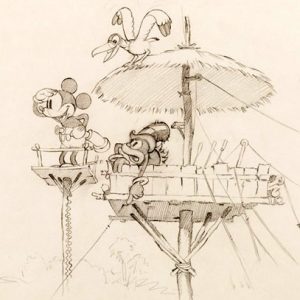 For those of you who’ve ever seen an episode of Hanna Barbera’s “Lippy the Lion and Hardy Har Har”, this cartoon next provides the obvious inspiration for that series’ opening credits sequence. As more and more spears hit the pole of the observation tower, Friday finds that they are forming an eaily climbable spiral staircase around the pole. Friday thus begins to climb, seeking the safety of Mickey’s elevated position. He reaches a point, however, where a “step” is missing, and he can proceed no further. He hails down toward the natives, pointing their attention to the open gap. A spear arrives on cue, and Friday sends the native who threw it a little “thank you” wave, as he climbs to just under the platform of the command center. Friday doesn’t have to think long about how to climb above, as one spear finally finds its mark, making sharp contact with Friday;s rear end, causing his to jump straight upwards through a hole in the command center floor. The cannibals, however, aren’t entirely brainless, and, witnessing Friday’s trick, realize they can do the same. A large contingent of natives begin to climb the staircase after our heroes. Mickey realizes that it’s time to abandon the stronghold position, and look for a means of escape. Ever resourceful, he has planned for such emergency, bu means of a long rope fastened from the tower roof to a tree far outside the compound. (Thank goodness none of the natives spotted the rope earlier for an exhibition of tightrope walking.). Mickey and Friday climb into a sort of “breeches buoy ” basket suspended from wheels straddling the rope, and pull a release lever of the type one would find in those days on small baskets for movement of parcels ot produce in an old fashioned grocery or general store. The basket is spring-launched away from tower and down the rope, with its passengers inside. Even now, our heroes are not out of danger, as a spear rips apart the bottom of the baskey, causing Mickey to replace it with the backup material of an inverted open umbrella. Another spear shatters this, and our boys switch to tightrope walking. Yet another spear severs the rope behind Mickey, but the boys keep racing ahead, with Mickey holding up the rope against gravity by taking up the fallen shack with hand-over-hand maneuvering as he runs. Unfortunately, when another spear severs the rope ahead of Friday, no stretch of cartoon physics is going to keep our heroes aloft any longer. Luckily, they have proceeded far enough to reach the shoreline, and land on board the deck of Mickey’s new and improved raft, which has now been converted into a power boat, by the use of four turtles with their necks harnessed to an automobile-like drive shaft, atop which is a matching shaft to which are tied four fish. The turtles alternate in snapping at the fish just above their heads, propelling a screw propeller in the rear. Mickey steers the vessel from a forward wheel, while pulling a rope for intermittent whistles – powered by a rope around Friday’s belly, which forces hot air out of his large lips with the sound of a steam whistle. (Now, if you had this miraculous vessel all the time, why, Mickey, didn’t you and Friday just take off for home to begin with, and save yourself this four minutes of pure peril and chaos?) But by now, Disney and his writers probably figured the audience was too hyped up and out of breath to stop and figure out the implausibility of the ending – and, judging from how exhausted I feel just writing about it, their guess was probably right. As Mickey’s boat sails into the sunset, I sail too to a well deserved rest, until we take up keyboard, screen, and word processor for more next time.
For those of you who’ve ever seen an episode of Hanna Barbera’s “Lippy the Lion and Hardy Har Har”, this cartoon next provides the obvious inspiration for that series’ opening credits sequence. As more and more spears hit the pole of the observation tower, Friday finds that they are forming an eaily climbable spiral staircase around the pole. Friday thus begins to climb, seeking the safety of Mickey’s elevated position. He reaches a point, however, where a “step” is missing, and he can proceed no further. He hails down toward the natives, pointing their attention to the open gap. A spear arrives on cue, and Friday sends the native who threw it a little “thank you” wave, as he climbs to just under the platform of the command center. Friday doesn’t have to think long about how to climb above, as one spear finally finds its mark, making sharp contact with Friday;s rear end, causing his to jump straight upwards through a hole in the command center floor. The cannibals, however, aren’t entirely brainless, and, witnessing Friday’s trick, realize they can do the same. A large contingent of natives begin to climb the staircase after our heroes. Mickey realizes that it’s time to abandon the stronghold position, and look for a means of escape. Ever resourceful, he has planned for such emergency, bu means of a long rope fastened from the tower roof to a tree far outside the compound. (Thank goodness none of the natives spotted the rope earlier for an exhibition of tightrope walking.). Mickey and Friday climb into a sort of “breeches buoy ” basket suspended from wheels straddling the rope, and pull a release lever of the type one would find in those days on small baskets for movement of parcels ot produce in an old fashioned grocery or general store. The basket is spring-launched away from tower and down the rope, with its passengers inside. Even now, our heroes are not out of danger, as a spear rips apart the bottom of the baskey, causing Mickey to replace it with the backup material of an inverted open umbrella. Another spear shatters this, and our boys switch to tightrope walking. Yet another spear severs the rope behind Mickey, but the boys keep racing ahead, with Mickey holding up the rope against gravity by taking up the fallen shack with hand-over-hand maneuvering as he runs. Unfortunately, when another spear severs the rope ahead of Friday, no stretch of cartoon physics is going to keep our heroes aloft any longer. Luckily, they have proceeded far enough to reach the shoreline, and land on board the deck of Mickey’s new and improved raft, which has now been converted into a power boat, by the use of four turtles with their necks harnessed to an automobile-like drive shaft, atop which is a matching shaft to which are tied four fish. The turtles alternate in snapping at the fish just above their heads, propelling a screw propeller in the rear. Mickey steers the vessel from a forward wheel, while pulling a rope for intermittent whistles – powered by a rope around Friday’s belly, which forces hot air out of his large lips with the sound of a steam whistle. (Now, if you had this miraculous vessel all the time, why, Mickey, didn’t you and Friday just take off for home to begin with, and save yourself this four minutes of pure peril and chaos?) But by now, Disney and his writers probably figured the audience was too hyped up and out of breath to stop and figure out the implausibility of the ending – and, judging from how exhausted I feel just writing about it, their guess was probably right. As Mickey’s boat sails into the sunset, I sail too to a well deserved rest, until we take up keyboard, screen, and word processor for more next time.
(A final historic coda. Pencil drawings, and I believe a few painted cels, are known to exist of at least some shots of Mickey in the observation tower, redesigned in his 1940’s white- eyeballs mode, for use in a scrapped project entitled “Mickey’s Revival Party” – an effort to reanimate in Technicolor some favorite sequences of the past, as had been done with The Orphans’ Benefit. Perhaps, in the days of manpower shortage of the war, the notion of redrawing this ultra-elaborate short’s action sequences again was simply too costly to remain feasible.


 Charles Gardner is an animation enthusiast who toils by day as a member of LA Law – but by nights and weekends indulges in classic jazz and ragtime as a performer; and studies classic Hollywood cartoons… maybe a little too much.
Charles Gardner is an animation enthusiast who toils by day as a member of LA Law – but by nights and weekends indulges in classic jazz and ragtime as a performer; and studies classic Hollywood cartoons… maybe a little too much.



































































































































































“Where did Robinson Crusoe go with Friday on Saturday night?
Every Saturday night they would start in to roam,
And on Sunday morning they’d come staggering home.
On that island lived wild men with cannibal trimmin’,
And where there are wild men, there must be wild women!
So where did Robinson Crusoe go with Friday on Saturday night?” — George W. Meyer and Joe Young
I find it curious that none of the plethora of Robinson Crusoe cartoons of the ’30s ever used that song, which was a hit for Al Jolson in 1916. My mother had the sheet music, and the cover illustration cracked me up when I was a kid.
Krazy Kat was marooned on a cannibal island in “Kannibal Kapers” (1935), not to be confused with Disney’s “Cannibal Capers” (1930). But since they didn’t have the foresight to call it “Krazy Krusoe”, I’ll only mention it in passing.
It’s funny that in the Oswald cartoon, Robinson Crusoe dances with a close facsimile of Molly Moo-Cow, who would later star in a Robinson Crusoe cartoon of her own.
As for the Jewish fish in “Betty Boop’s Lifeguard”, it sounds to me as though he’s saying “I cash cone”, not “clothes”, but I have no idea what he means. It may be significant that his jacket is draped over his arm, or that he’s wearing five hats and carrying a megillah or scroll, but anyone’s guess is as good as mine. However, after Fishel sees the sea monster he says: “Oy, oy! A glus vasser! Ich chalash avek!” Which is Yiddish for “A glass of water! I’m going to faint!” It pokes fun at stereotypical Jewish hypersensitivity, and it’s also funny because, you know, a fish in the ocean is asking for a glass of water.
Krazy Kat and his girlfriend return to the beach in “Weenie Roast” (Columbia, 14/12/31 — Ben Harrison and Manny Gould, dirs.). As the titular frankfurters dangle over an open fire, the krazy kouple, the flame and the hot dogs themselves all vocalise wordlessly to the tune of “By the Beautiful Sea”. (Those two can never remember the lyrics to anything.) When the incoming tide douses the fire, Krazy tries to revive it by wringing the seawater out of the flame (no doubt why he wears gloves), then offers it some alcohol from a flask before successfully stoking it with pieces of driftwood. Then, leaving the fire unattended and the weenies uneaten, the pair decides to take in a nearby amusement park. But a hippopotamus carny’s sneeze sends their roller coaster car out of control, and it careens through a flea circus, a sideshow and a funhouse before rolling down a slide and into the ocean. Which is precisely the sort of thing that can happen to you when you disregard fire safety.
In “By the Sea” (Terrytoons, 12/7/31 — Frank Moser, dir.), Placide the mouse drives his flivver to his sweetheart’s house only to find her boop-oop-a-dooping with a feline lothario, who has come to take her on a date to the beach. After emerging from the bathhouse in their antiquated bathing costumes, the cheating couple swim in the surf and play leapfrog on the sand as Placide watches dejectedly from a fishing pier. In the midst of all this canoodling, a fearsome octopus seizes Mousette in his white-gloved tentacles and carries her off to sea. The cowardly cat flees in terror, but Placide rips off his suit, dives into the briny, conks the cephalopod on the noggin and drags the girl back to shore. There, she kneels at his feet, strokes his thigh, and sings the same “Boop-oop-a-doop” song that she sang to the cat in the opening scene. All is forgiven: Placide and his girlfriend kiss passionately as the cuckolded cat blows them a raspberry for the iris out.
In “See the World” (Terrytoons/Educational, Puddy the Pup, 29/6/34 — Frank Moser and Paul Terry, dirs.), a naval vessel is cruising over the ocean when Able Seaman Puddy, up in the crow’s nest, sees a group of beautiful native girls dancing seductively on the beach of a tropical island. The sailors promptly break out the lifeboats and effect an amphibious landing. The girls are vastly outnumbered by the gobs, but they don’t seem to mind. Puddy, meanwhile, sings a light operatic duet with a winsome island girl because, you know, it’s Terrytoons. But just as things are getting interesting, duty calls, and a bugle summons the sailors back to their ship. In parting, Puddy gives his girl a series of passionate kisses that leave her dizzy and breathless, until she falls over onto the sand in a faint.